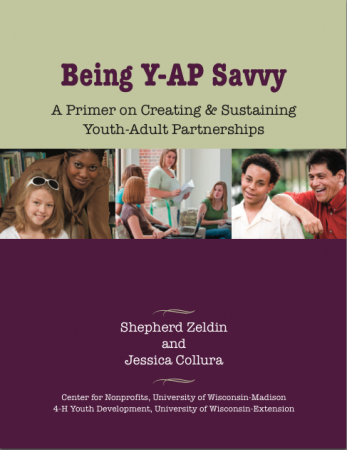
Youth and Adult Partnerships in Organizations and Communities:
Practical Resources for Planning and Implementation
Jessica Collura and Shepherd Zeldin
Youth-adult partnership (Y-AP) is a powerful strategy of organizational improvement and community change. When youth and adults participate in collective decision-making and action, communities and organizations can ensure the needs of all stakeholders are met. In fact, research demonstrates that intergenerational partnerships benefit youth development and adult competency and confidence. Moreover, organizations and communities gain a greater capacity to respond, through policy and program, to the critical interests, concerns and priorities of young people.
Many adults, however, are uncertain how to work collectively with young people. This uncertainty is understandable. Y-AP is an innovative approach to working with young people; it is distinct from more traditional models of youth-adult relationships, such as mentors or apprentices. Y-AP involves multiple youth and multiple adults working collectively over a sustained period of time to strengthen an organization or address a community issue. This collective effort – including deliberation, reflection and action – is fundamental to the practice of Y-AP.
Y-AP also recognizes, and builds on, the unique skills and assets that each youth and adult bring to the table. Y-AP does not assume that adults have all the necessary expertise or that young people have all of the creative energy. Roles and responsibilities, therefore, are not determined by age, but rather by the specific skills and interests each person brings to the group.
Resources for Individuals and Groups
Our team at the University of Wisconsin-Madison has collaborated with community organizations to address the uncertainties surrounding the practice of Y-AP. Resources have been created to that end (http://fyi.uwex.edu/youthadultpartnership). When individuals request assistance, we refer them to a brief narrated powerpoint called “Youth-Adult Partnership: Involving Youth in Decision-Making.” This introductory presentation helps community workers grasp the core concepts of intergenerational partnership.
Ultimately, however, organizational and community change occurs through groups of people working together toward a common cause. Change is a collective effort. For that reason, we advise organizations to focus on a manual called "Being Y-AP Savvy: A Primer on Creating and Sustaining Youth-Adult Partnership." Being Y-AP Savvy seeks to build individuals' knowledge about Y-AP, while concurrently, guiding groups through a process of collective decision making to strengthen Y-AP within their organization.
Being Y-AP Savvy: Structure of the Manual
Being Y-AP Savvy is designed to guide organizations or community groups in building consensus about the practice of Y-AP. It is structured around six essential questions:
We devote one chapter to each question. At first glance, the essential questions may appear simple. But do not be fooled. These seemingly basic questions are often the most challenging to answer. If your organization is able to agree on answers to these questions, it will be well prepared to implement quality Y-AP.
Each chapter is oriented around helping you answer these essential questions. The “Necessary Knowledge” section presents contemporary research and practitioner knowledge on the practice of Y-AP. The “Tools” section provides activities for groups to apply the knowledge to their own organization or community.
The brief chapters build on one another. Together, they take groups through an entire planning process culminating with an implementation plan.
Tips for Using Y-AP Savvy
We offer four suggestions to guide youth and adults interested in using Y-AP Savvy with their organization or community group:
Complete the Chapters and Tools Over Time
This manual should not be completed during one organizational meeting. Youth and adults need time to reflect on the planning process. We recommend that organizations schedule a series of meetings dedicated to discussing this manual and completing the tools.
Develop a Personal Perspective and Share it With Colleagues
The true power of this manual is the discussion and collective understanding it fosters. But before individuals can engage in discussions, they should be given time to reflect and develop their own perspectives. After this period of reflection, members should be encouraged to share their ideas with the group. Expression is key. It is not enough to simply develop personal opinions and ideas. These ideas must be shared with colleagues for true consensus to be reached. Y-AP Savvy provides tools to unleash the power of personal reflection and group discussion.
Adapt the Tools as Necessary
The developed tools are not meant to be prescriptive, but rather to call attention to the critical questions and issues that need to be discussed when designing and implementing Y-AP. Organizations should feel free to make adaptations, particularly those that might lead to more fruitful or participatory discussions. The key is to still ensure that the core content is discussed and the essential questions are answered.
Use the Tools for Ongoing Organizational Improvement
There is value in returning to the essential questions and using the tools for ongoing organizational improvement. When organizations return to Y-AP Savvy, they may find that not every Tool needs to be completed. This is fine. When using the manual for ongoing improvement, organizations might choose to review and identify the essential questions and activities that need to be discussed, rather than completing the entire manual again in sequential order.
Final Note
We welcome the opportunity to learn more about how your organization uses these resources. Please share your comments, questions, and success stories with us.
Jessica Collura and Shepherd Zeldin
Jessica Collura (collura@wisc.edu) is a Ph.D. candidate and instructor in Civil Society and Community Research at the University of Wisconsin-Madison. Her work focuses on youth organizing, youth engagement in community networks, and best practices in youth-adult partnerships.
Shepherd Zeldin (rszeldin@wisc.edu) is a Rothermel Bascom Professor of Human Ecology, and chair of the graduate program in Civil Society and Community Research. His interest is in the integration of research-based knowledge with practitioner expertise to strengthen community organizations.
![]() Download the PDF version to access the complete article.
Download the PDF version to access the complete article.
Keywords: youth-adult partnerships, community psychology, gjcpp